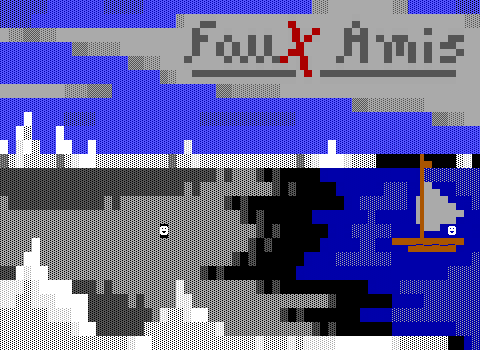Going Deep In The Dungeons
George's adventure brings him through a total of five dungeons. These areas differentiate themselves from the rest of the world in a number of ways. They're generally darker. They include enemies that aren't just built-ins. They have a few rare instances of puzzles, and they scale the board size down in order to display extra information.
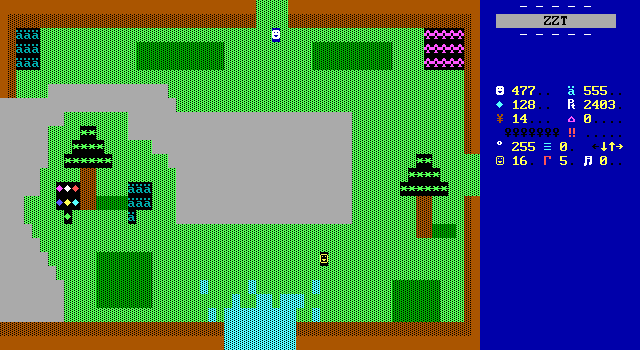
The outside world paints its terrain with fake walls. Most boards are the expected grassy shades of green, with some variety when traveling to deserts or lava-lands. The friendly interiors of towns include colorful carpeting as well. In the dungeons, players traverse boards that more often stick to empties for both flooring and their backgrounds. Floors are instead reserved here for treasure rooms or notable boss fights.

Danger in the depths comes from the use of objects for enemies. Regular foes still make appearances, just now upon entering a board players can't be certain what they're about to go up against until they observe how things move and shoot. RinGames gives these creatures names, but as every non-boss is a one-hit kill, there's never an opportunity to learn them. Dragons, skeleton warriors, evil knights (caballeros), ghosts, polar bears, and penguins are just some of the enemies players encounter. It's a squandered chance to inject some flavor into the game as until the game's final moments all of them are identical in behavior.
Every enemy runs a basic loop of shooting towards the player, idling, moving towards the player, and idling again ad ad nauseam. They don't get a chance to shine, and the game's dungeons suffer quite a bit from how often enemies end up just shooting one-another.
There are times when I find myself trying to engage with enemies like this, rushing in so they can be the threats they were intended to be, but in SaintZZT 7th the positioning often leads to enemies being destroyed regardless of how quickly the player moves. Playing on hard mode might mitigate things somewhat, as the slow advancement towards the player on medium means enemy bullets move faster than the enemies themselves, limiting opportunities for the foe to dodge.
Puzzles meanwhile, are a bit of a rarity. Especially ones that go beyond the most basic of ZZT puzzle designs.
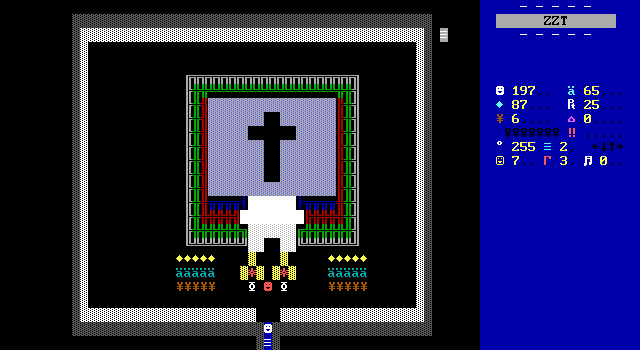
The first dungeon has a tranquil room with a holy man that tells George he must walk through walls if he's to make it through. Oh joy. Find the fake wall.
Thankfully, it's not as tedious as it could be. Players can see the exit passage in the corner, and hopefully will aim for that region when they begin everyone's favorite past-time of touching every tile until they touch the correct one.
Once out of bounds a near ping-pong-path bordered by invisible walls needs to be traversed as well. All of this is nothing more than filler, though the presentation helps make it a little more bearable. There's also always something fun about getting to go outside the walls, even if it's so blatantly telegraphed like this.
It's no brain teaser, and I can't really say it adds much to the game, yet I can't really be upset by it. It feels like something that fits in with the game's style, a little rough, but with enough love put into it that it's clear RinGames didn't feel like it was filler as they made it.
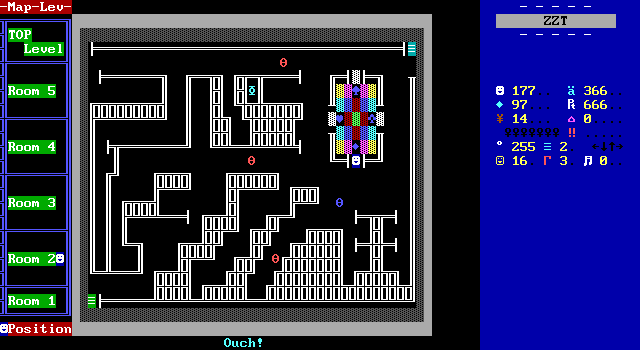
This puzzle is one I was going to use as my example of RinGames doing a nicer job, until I went back to look up the actual solution. Here, an invisible barrier blocks access to the exit, with this strange arrangement of playing card suits. After pressing a few, I made the barrier go away.
But it isn't a case of finding the right order to touch the suits in like I thought. The answer is just touch the spade. The others all inflict some form of harm on the player. The heart takes a single health point. The club places a lion in front of the player, and the gem shoots at you. There doesn't seem to be any
I can't find any logic to this. I figured I just missed some hint, maybe a non-obvious one, but as far as I can tell this is just a guessing game. Nothing in the dungeon mentions card suits, no NPCs discuss it, and that scroll that's on the board and inaccessible is blank if you were to cheat to it.
So puzzle design may not be RinGames's strong suit. (Pun not intended.)
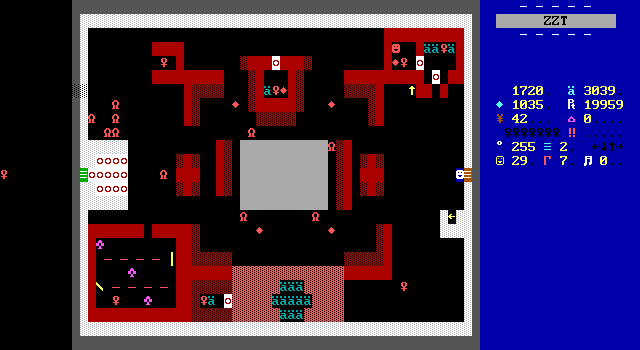
Takeda castle rehashes the "find the fake wall" trick, albeit on a busier board with a number of keys to collect. Despite a red key being the only thing outside the main board, I didn't even notice it until I was down to the last. Somehow, it feels like a weaker inclusion here, perhaps because the rest of the board is a perfectly fine action sequence. Before, it established that players may need to travel to unconventional places (even if that's hardly been the case), here it's just some last minute busywork.
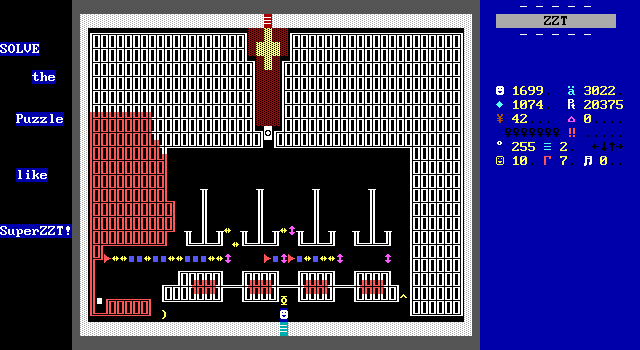
There's really only one more that appears in the final dungeon. A slider puzzle lifted straight from Super ZZT's Monster Zoo. It's credited at least, though with the ability to see the entire design all at once, it's a lot easier. I don't think I ever realized just how simple a puzzle it is before now. Normally I'm second guessing myself every time I push something.
What I do like about the dungeons is the sizing. Shrinking the board down just a little bit makes things go a little faster, and gives RinGames an opportunity to take advantage of the extra space for other information. A lot of the themeing of the dungeons comes through in the outer layer.
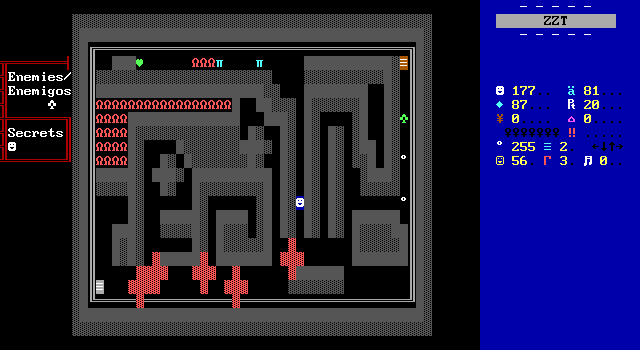
Early on, RinGames tries to turn the extra board space into game UI, something that I think is a pretty cool idea. Players can get live tallies of enemies killed and secrets discovered, a great way to make use of the space.
This isn't done with counters, but with dedicated objects for each secret to uncover that appears in a dedicated spot when it needs to. This has the benefit of letting players know if they've missed anything, albeit at the cost of not really being confident that they've gotten everything, as there's still room for more objects when all is said and done. For enemies, this is reversed, showing a list in advance and then blanking out the tile when the associated enemy is killed.
RinGames's idea of a "secret" is also kind of baffling. Were this a way to help guide players to finding hidden treasures or something, this would be a neat little mechanic. Instead the secrets are really just the items collected. Everything is already visible on the board, so nothing feels like it's a secret even though it will be marked as such.
The outer UI also runs into an issue where it can't be used on dark boards which show up now and again. On these screens the entire system is just discarded outright. There's no clean solution to this problem. You could mark off secrets by having a torch appear that would still be visible in darkness, but even then you wouldn't be able to see the text.[1]
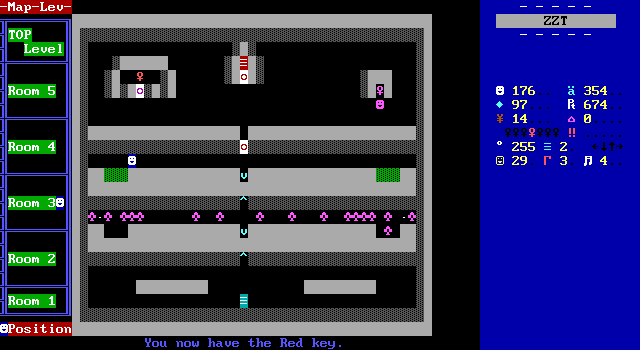
Later dungeons go for a little progress meter as you ascend to the top of the level. Shame that there's no consistency here, but this is another good use of the space.
Players now get a feeling of tangible progress with each board, and the excitement of knowing when the next board is going to be the last.
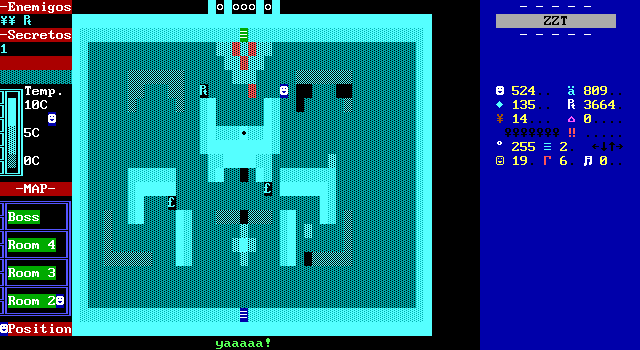
Still not satisfied, RinGames finally puts it all together with yet another new idea in the ice dungeon. Here, the map is combined with the enemy/secret meters, and for some good themeing, tracking the current temperature. As George makes the climb, the rooms get progressively colder ...at least according to the UI.
In practice, this is another little bit of playing pretend, with no gameplay mechanic attached. Granted, at these temperatures, George probably shouldn't be taking cold damage, but he may want a heavy coat by the end of it. A more complex game could do some fun stuff with this meter, requiring players to find sources of warmth, taking damage over time if they get too cold, or perhaps going so far as to slow down the player's cycle so they can't move as quickly in frigid temperatures.
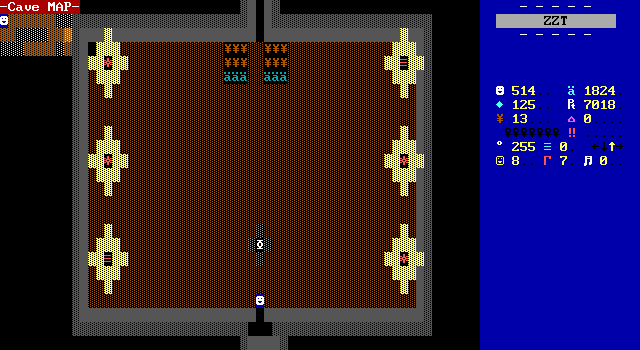
And then it changes once more. This time to include a tiny map that's incredibly useless. It's a progress meter more than anything, with the player's position on the map from board to board jumping by several spaces. Combine it with the ever-shifting position of the map itself on the screen, and it quickly becomes something to just tune out.
None of the dungeons ever deviate from the screen-to-screen design, so there's no way to get lost. Players can only ever go forward, and now that the movements are inconsistent compared to marking floors, the map isn't even useful to figuring out if you're nearing the end of the level or not.
Even though most of the concepts implemented within the dungeons are a bit half-baked, they do contribute to the overall mood of the game. The little interfaces that play pretend do give the game more of a console game vibe. Given how often you get oversized boards, empty backgrounds, or plain ones, using the extra space like this is a welcome change of pace.
Final Thoughts
As far as jumping into the middle of a series goes, Saint ZZT 7th wasn't a bad pick at all. The game stands on its own rather nicely, partially due to obvious lack of story, partially from just sticking to a very simple adventure game formula.
It's a game reminiscent of a lot of classics. The Zelda inspirations certainly bring to mind Link's Adventure. The world-traveling is a touch Tankia: The Sword of Lightning. The way that each town is a checkpoint along a greater journey like Castle Siege or Adventure. RinGames follows the arch-typical ZZT adventure blueprint without following it to the letter. The way the game's overworld suddenly receives a level of focus equal to its dungeons, and how that final dungeon encompasses space that would normally have been overworld. It turns the game into something that feels unique to the glut of adventure games out there.
And that's a good thing, because for all the positives, the game does seem to be in need of some refinement, even for what is already an "enhanced" version. Those changes mostly amount to a graphical overhaul, taking an average looking game and honestly, continuing to look pretty average. The real spots that could use improvement: repetitive enemy designs, weak puzzles, the hidden library book and awkwardness in acquiring it later. It's mostly small stuff, easy to ignore when distracted by shiny novelties in faux-UI.
I left Saint ZZT 7th interested in seeing more. For all the flaws, the actual experience of playing through the game is pretty smooth (sans library). It easily held my interest with its variety in dungeon styles, a pleasant overworld, and odd dialog. At its heart, the game is a fun one, even if it's not the most technically impressive or masterfully designed. I suspect the series might make for a good stream game, being able to share those moments of surprise as you enter a new screen and see a totally different biome before you, getting a chuckle at the bits of poorly translated text, and just seeing what strange items George will need to acquire to accomplish his goal. Whatever that may be. I still have no idea who Takeda is...
- [1]Okay, technically you could use undefined elements that render as text and happen to be visible in darkness through a fluke of memory to keep the UI on screen. I don't think anybody knew about Kryptonite text, whose behavior tends to be somewhat spotty at best, and will just crash ZZT at worst. As UI the crash on touch bug would at least be easily avoidable.

